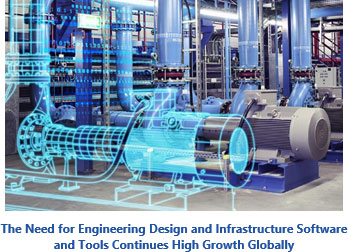




This evaluation and selection guide will help organizations select the best plant engineering design tools (EDT), infrastructure design applications, and building information modeling (BIM) software for their business and infrastructure requirements.
The need for plant engineering design tools (EDT), infrastructure design applications and building information modeling (BIM) continues high growth globally.
EDT involves plant design mostly by engineering, procurement, and construction (EPC) companies for the process industries including downstream oil & gas, refineries, chemical plants, electric power generation, water treatment plants, etc.
 BIM involves the architecture, engineering, and construction (AEC) companies that support infrastructure projects including roads, bridges, buildings, upstream oil & gas, pipelines, power transmission and distribution (T&D), water distribution, etc.
BIM involves the architecture, engineering, and construction (AEC) companies that support infrastructure projects including roads, bridges, buildings, upstream oil & gas, pipelines, power transmission and distribution (T&D), water distribution, etc.
Engineering and design tools historically were optimized for the plant design and engineering stakeholders which focused on EPCs or AECs. Now, EDT/BIM offerings have morphed into more robust collaborative agents that can be utilized for the entire lifecycle of the infrastructure or plant including the owners for operations and maintenance.
Executing these massive projects often requires joint ventures or partnerships between engineering, construction, and owner-operator organizations. Faced with a large and varied selection of design/build applications and suppliers from which to choose, engineering firms and owner-operators alike often need guidance to make the right choices.
Beyond the project phase, asset owners are now seeing the additional value that engineering design tools can provide during the much longer operations phase of assets in both plants and infrastructure.
For new and expensive CapEx greenfield projects, plant owner-operators are increasingly using engineering design solutions at earlier project stages. This enables continuous handover for faster time to high operational performance with good margins and profitability. This extends to subsequent upgrades for improving in the operations and maintenance phase of the asset’s lifecycle. Owner-operators pressure the EPCs to become involved in the initial stages of plant design. The owner-operators can then submit requirements for handover including operational and maintenance information and documentation. In this way, owner-operators can take a proactive part in defining handover content and avoid “surprises” when the actual handover occurs.
Plant and infrastructure design software solution providers now offer solutions that address the information management issues resulting from siloed business processes and related inefficiencies. They have extended their solutions to span the various stakeholders including designers (front end engineering design and detailed design), construction contractors, and owner-operators (operations and maintenance).
Digitalization reduces dependence on paper documents and ad hoc business processes; it enables improved and automated business process management throughout the asset lifecycle using plant and infrastructure design software. EPCs and AECs can provide better information management during and after the handover process.
The plant and infrastructure domains each have different market dynamics. Users need to know the capabilities and strategies of suppliers for their particular market. Additionally, both EPCs and owner-operators need to be aware of the market and relevant technologies. This study answers key questions, such as:
For more information on this technology guide or to discuss how we can help you, please contact us.




